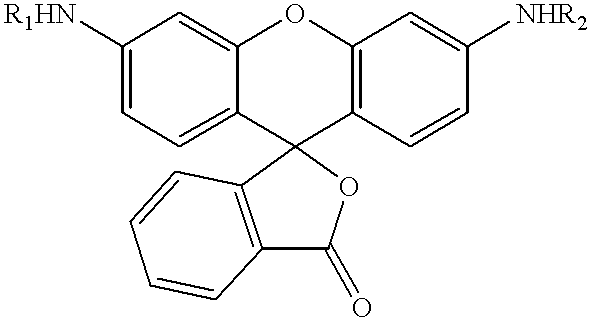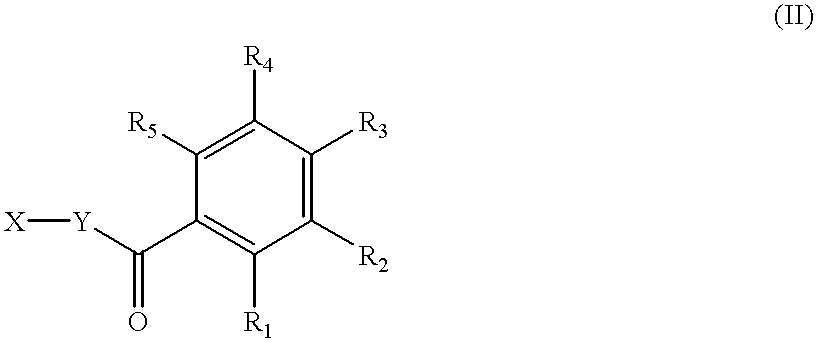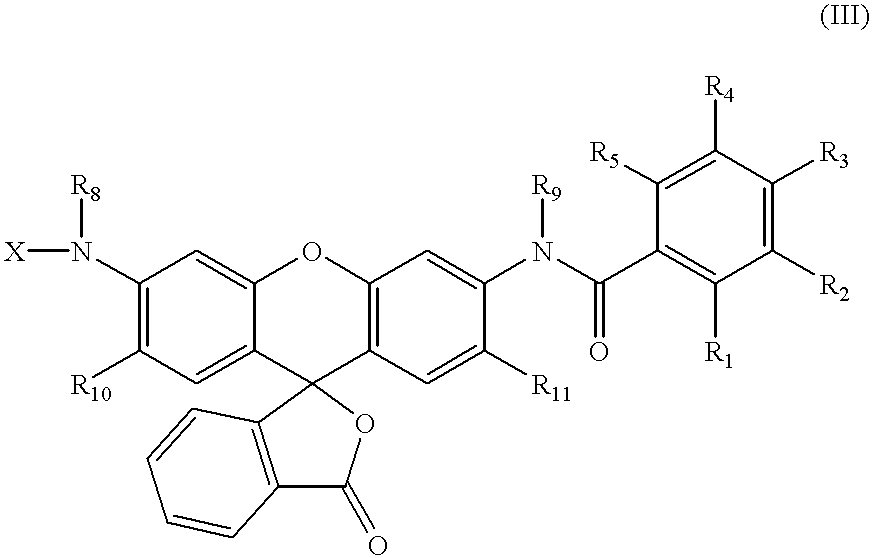Fluorescence dyes and their applications for whole-cell fluorescence screening assays for caspases, peptidases, proteases and other enzymes and the use thereof
a technology of fluorescence and dyes, applied in the field of fluorescence or fluorescent probes for intracellular detection of enzymes, can solve the problems of cell death, excessive cellular suicide, organ failure, etc., and achieve the effect of not allowing inner cellular screening for compounds in htca assays
- Summary
- Abstract
- Description
- Claims
- Application Information
AI Technical Summary
Problems solved by technology
Method used
Image
Examples
example 2
N-[Z-Val-Asp(OBut)]-N'-pentafluorobenzoyl-Rhodamine 110
To a solution of Z-Val-Asp(OBut) (103 mg, 0.25 mmol) dissolved in an anhydrous 1:1 mixture of dimethylformamide and pyridine (1 mL) at 0.degree. C. was added EDC (47 mg, 0.25 mmol) and the solution was stirred for 20 min, then a solution of N-pentafluorobenzoyl-Rhodamine 110 (25 mg, 0.047 mmol) in the same solvent (1 mL) was added. The reaction mixture was stirred at room temperature for 5 days and was then diluted with 100 mL of water and extracted with ethyl acetate (3.times.50 mL). The organic phase was washed with 1N HCl (3.times.30 mL) and water (2.times.50 mL). The solution was dried over Na.sub.2 SO.sub.4 and concentrated to give crude product, which was purified by column chromatography (EtOAc / CH.sub.2 Cl.sub.2 =1:8), gave 20 mg (46%) of the title compound as a solid. .sup.1 H NMR (CDCl.sub.3): 9.02 (bs, 1H), 8.90 (bs, 1H), 8.01(bs, 1H), 7.80(bs, 1H), 7.70-7.50 (m, 4H), 7.31 (m, 5H), 7.22-7.10 (m, 2H), 6.80-6.75(m, 2H), ...
example 3
N-(Z-Val-Asp)-N'-pentafluorobenzoyl-Rhodamine 110
To a cooled solution (0.degree. C.) of N-[Z-Val-Asp(OBut)]-N'-pentafluorobenzoyl-Rhodamine 110 (17 mg, 0.018 mmol) in methylene chloride (1 ml) was added 50% trifluoroacetic acid in methylene chloride (2 mL), the solution turned orange and was stirred at room temperature for 4 h. The solvent was removed and the crude product was purified by flash column chromatography to yield 15 mg (96%) of the title compound. R.sub.f =0.45 (10 mL EtOAc with 5 drops CF.sub.3 CO.sub.2 H). .sup.1 H NMR (CD.sub.3 OD): 8.02 (d, J=6.9 Hz, 1H), 7.88 (s, 1H), 7.82-7.70 (m, 3H), 7.40-7.20 (m, 8H), 6.82 (d, J=8.4 Hz, 1H), 6.72-6.62 (m, 1H), 5.11(m, 2H), 3.90 (d, 2H), 3.79 (d, 2H), 3.18-3.00 (m, 1H), 2.96-2.78 (m, 1H), 2.05 (m, 1H), 1.05-0.98 (m, 6H).
example 4
N-(Z-Gly)-N'-pentafluorobenzoyl-Rhodamine 110
From Z-L-Gly (523 mg, 2.5 mmol), EDC (479 mg, 2.5 mmol) and N-pentafluorobenzoyl-Rhodamine 110 (131 mg, 0.25 mmol) was obtained 151 mg (84%) of the title compound as a solid. .sup.1 H NMR (CDCl.sub.3): 8.82 (s, 1H), 8.52 (s, 1H), 7.97 (m, 1H), 7.68-7.60 (m, 2H), 7.38 (s, 1H), 7.32 (m, 6H), 7.16 (m, 1H), 7.08 (m, 1H), 6.68-6.60 (m, 2H), 6.00 (bs, 1H), 5.14 (s, 2H), 4.04 (bs, 2H).
PUM
| Property | Measurement | Unit |
|---|---|---|
| temperature | aaaaa | aaaaa |
| volume | aaaaa | aaaaa |
| concentration | aaaaa | aaaaa |
Abstract
Description
Claims
Application Information
 Login to View More
Login to View More - R&D
- Intellectual Property
- Life Sciences
- Materials
- Tech Scout
- Unparalleled Data Quality
- Higher Quality Content
- 60% Fewer Hallucinations
Browse by: Latest US Patents, China's latest patents, Technical Efficacy Thesaurus, Application Domain, Technology Topic, Popular Technical Reports.
© 2025 PatSnap. All rights reserved.Legal|Privacy policy|Modern Slavery Act Transparency Statement|Sitemap|About US| Contact US: help@patsnap.com



